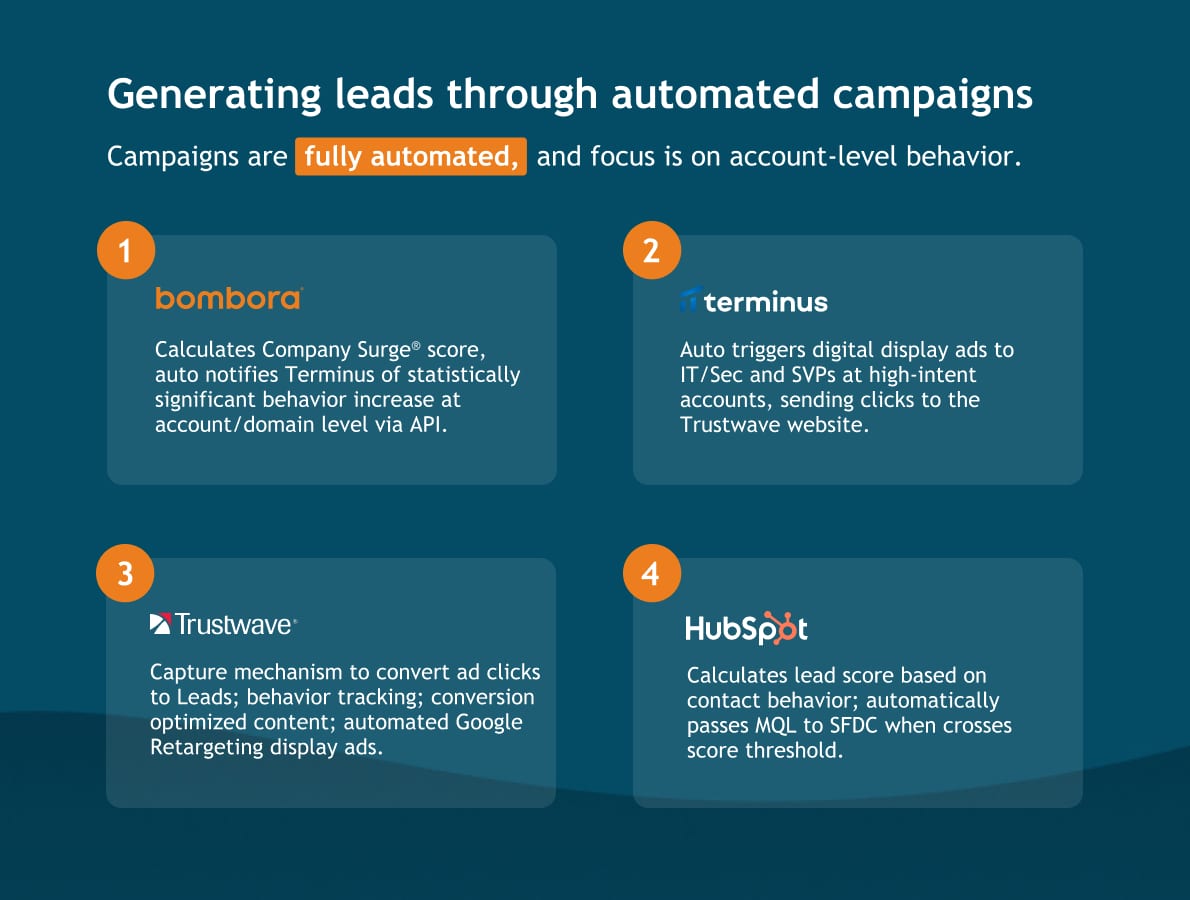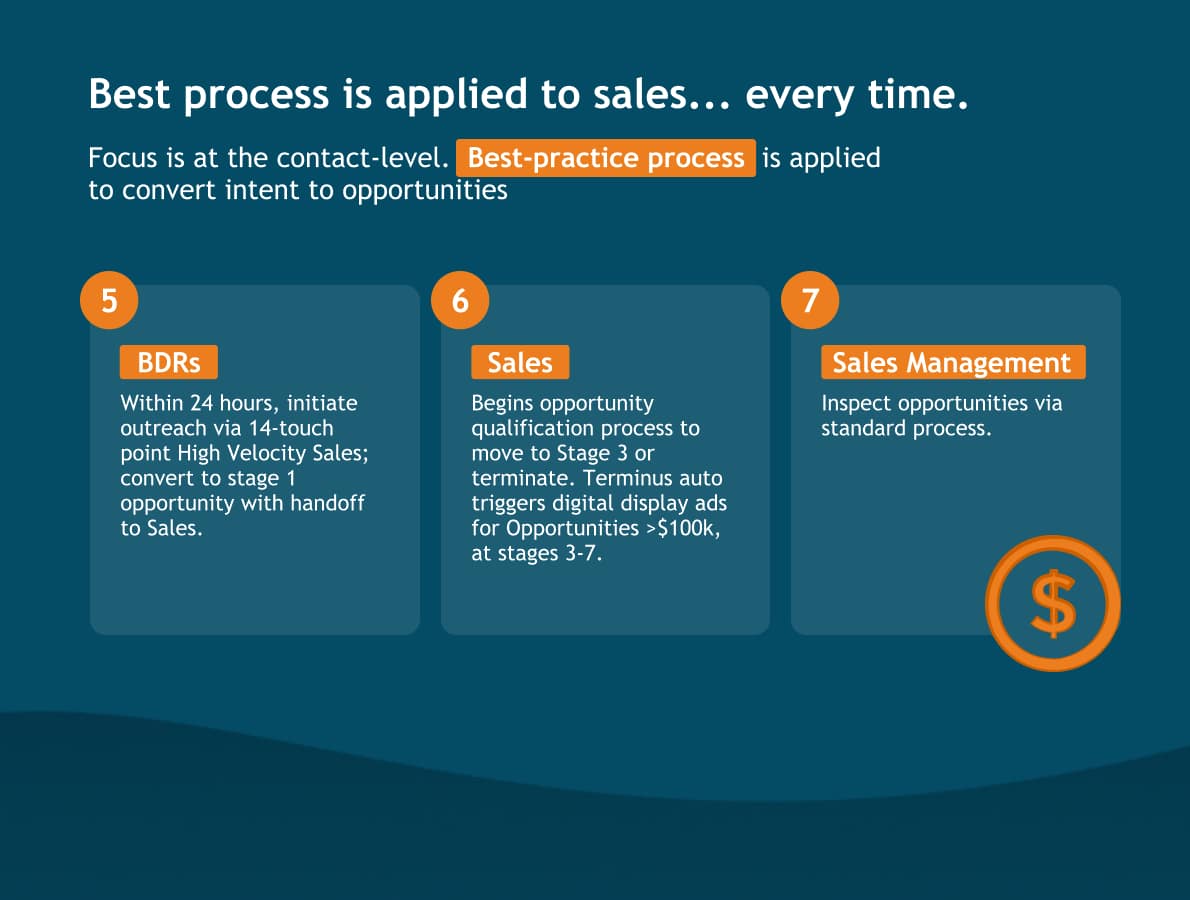Accelerating cybersecurity demand generation & lead management with Intent data
Intensifying change and competition
Inflation and recessionary pressure continue to plague virtually every market, but cybersecurity is a strong contender for king of concurrent challenges. And there’s a major disturbance that most B2B businesses cannot relate to.
“The Russia-Ukraine conflict has created a whole bunch of challenges and opportunities for us,” said Craig Rones, CMO at Trustwave. “For the first time in modern warfare, we see cyber tactics deployed at scale, and we’re able to monitor threat actors moving beyond borders to exploit corporations.”
Since 2022, the cybersecurity services provider has also seen a lot of internal change: a rip-and-replace of its MarTech stack; moving ABM in-house; migrating its CMS; and 60% turnover in marketing staff.
Despite being one of only six vendors featured in its industry’s four main Gartner Market Guides (Managed Security Services [MSS]; Managed Detection and Response Services [MDR]; Digital Forensics and Incident Response Retainer Services [DFIR]; and Managed Security Information and Event Management Services [SIEM]), Trustwave’s varied competitive landscape was jam-packed.
“Gartner evaluates over 1,400 vendors in just those four markets, so we have over 1,400 competitors I know of,” revealed Rones, “and a lot more because we also ‘compete’ with in-house cybersecurity teams.”
Like many B2B businesses, Trustwave decided to deploy an Intent data solution in order to:
- Improve results of shrinking teams through sales prioritization
- Boost pipeline contribution in demand generation and lead management
- Increase GTM competitiveness in a rapidly changing field
From his experience, Rones knew that reconfiguring sales processes was also essential to achieving these goals.
“We needed to get to where the language we’re speaking matches the language the client’s looking for,” he said. “When bringing the human interactions and the data we receive together, you start to get some magic that sits in the middle.”
Read on to see how Trustwave used Intent data, and how you can emulate their success.
Discover In-market accounts faster
This mission was a huge undertaking for Rones and his marketing team, especially with Trustwave in flux. But the starting point was clear, with 70-90% of a buyer’s research journey already complete before they make contact, according to Forrester.
“We needed to transform our lead management processes while unleashing the talent of our existing team,” he recalled. “But first, it was crucial to better understand who was ‘in-market’ — and for what — to reach them at the appropriate time.”
In addition to “incumbent bias” hindering efforts to gain net new accounts, cybersecurity customers’ rate of change in their preferences was “beyond belief,” according to Rones.
–Craig Rones, CMO at Trustwave
In order to reach prospects in the first 10-30% of a buying cycle — where research begins, usually following budget approval — Trustwave deployed Bombora Company Surge®.
Bombora’s Intent data is fueled by the most comprehensive privacy-compliant Data Cooperative on the web. With it, Trustwave could reach “warmer” accounts earlier, targeting them based on consumption of content denoting research and in turn, buying Intent.
How can you emulate their success? Follow these steps to Intent data-guided demand generation:
- Determine your Intent topic clusters in Company Surge® – These are groups of closely related Intent topics that together comprise all facets of a product or service.
- Generate and view a surge report – This is a weekly report that displays:
- Surge score – This means the intensity of research between a company and a topic compared to its historical baseline. A company showing buying Intent on a topic would score a 60 or higher.
- Topic count – This is the number of topics that exhibit a surge score of 60 or higher on a given account, with the higher the topic count, the higher the buying Intent.
- Delta – This is the change in research activity for a topic compared to the previous week. Bombora provides up to 18 months of an account’s Intent data.
- Always sort by topic count first, then by average surge score – The companies at the top of the list should top your outreach schedule.
- Next, look at the delta column to see the largest week-over-week increases in research activity – The accounts with the largest changes — whether plus or minus — should also be priorities.
- Drill down to topic clusters, competitors, and geography of contacts “spiking” to build a list of those showing the highest buying Intent.
- Integrate Company Surge® with your demand generation, CRM, and other systems – Your business can integrate Bombora solutions with many leading platforms.
Intent-based account intelligence can dive deeper into prospects’ wants and needs than was ever possible, allowing you to precisely target your messaging at all the right places. Bombora’s Audience Solutions allows you to advertise to in-market audiences from your target account list or based on intent via custom audiences from five datasets: profile, behavioral, install, ABM, and Company Surge®.
And Intent-based account intelligence can be strategically implemented to monitor your customers too. We’ll dive into that in a bit and the winning workflow Trustwave implemented to drive big sales impact.
Intent-driven account intelligence
After deploying Company Surge®, the Trustwave marketing team applied Intent data insights to their new two-pronged approach to demand generation. Tier 1 accounts and prospects would have a high-touch model inclusive of display ads and events, while mid-market accounts and prospects were reached by automated campaigns using HubSpot and Terminus.
–Craig Rones, CMO at Trustwave
“Like everyone, we had a need to prioritize our scarce resources to drive the greatest impact to our business,” Rones said. “Unfortunately, our marketing investment is not limitless.”
The marketing team used Company Surge® to refine its target account list (TAL) to have a higher concentration of accounts with buying Intent. The table below outlines the three account groups Trustwave targeted.
| Account group | Possible with Bombora Intent data |
|---|---|
| Existing whitespace customers, including highest revenue-generators | Upsell and cross-sell based on offering-related topic surges |
| “Dead deal” accounts that were lost to another vendor or have a small Trustwave footprint | More timely outreach to a larger portion of the buying committee and relevant messaging based on Bombora and sales intelligence |
| “Look-a-like” accounts that match ideal customer profiles | Focused outreach at the right time with the right content based on topic cluster data |
“With Bombora, we could identify otherwise unknown accounts and perform targeted outreach via content syndication, LinkedIn, digital display ads, and even email,” Rones said. “Intent data helped us infiltrate every one of those communities of accounts.”
Programmatic and people in unison
For mid-market accounts and prospects being reached through automated campaigns, the Trustwave marketing team used Intent data to marry contact-level targeting with account-level insight. But more efficient lead management required close coordination with sales teams.
“If your systems and your sales staff don’t work well together, you are sub-optimized,” said Rones. “Speed to engagement is key.”
The seven-step process begins with Company Surge® and integrates with the Terminus ABM platform, Trustwave, HubSpot, and Salesforce before BDRs take the baton (see below for the full seven-step flow).


- Bombora Company Surge® calculates a surge score and auto-notifies Terminus of any significant behavior change at the account/domain level.
- Terminus auto-triggers digital display ads to IT/Sec and SVP contacts at a high-Intent account, sending clicks to the Trustwave website.
- Trustwave captures ad clicks and converts them to leads; tracks behavior; deploys conversion-optimized content; and launches Google Retargeting ads.
- HubSpot calculates a lead score based on contact behavior, and automatically passes an MQL to Salesforce once it crosses the score threshold.
- A BDR receives the account and within 24 hours initiates outreach, before converting it to a “stage 1” opportunity and handing it off to an AE.
- The AE begins opportunity qualification and either terminates it or moves it to “stage 3” (Terminus auto-triggers digital display ads for opportunities over $100k at stages 3-7).
- Sales management inspects the opportunity via standard processes.
“Most of this is fully automated with predefined workflows, and engagement models handling the rest,” Rones celebrated. “Bombora allows us to take demand signals at an account level, engage at a contact level, and drive impact — it’s almost the holy grail of marketing.”
Partnership through prioritization
Rones and his marketing team have been enjoying a stronger relationship with sales through this Intent-driven demand generation model. By prioritizing leads closer to buying readiness, they’ve been able to slash ill-advised outreach — exponentially.
“A CISO, who’s a decision-making role we’d target, said he receives 167 unsolicited vendor emails every day and 43 calls a week,” Rones recounted. “Only one time a quarter he actually returns a call or email.”
Swapping blind, high-volume outreach with Intent-data verified account lists has brought large gains for Trustwave, including:
- 160% increase in marketing-sourced pipeline
- BDR follow-up time reduced from one week to 90 minutes
- 51% better MQL conversion rate
- 56% reduction in lead “noise”
“We’ve taken our lead quantity down over 56%, and I can’t tell you how helpful that’s been in our conversations with sales,” Rones insisted. “It gets noise out of the system that kills sales efficiency, because they’re no longer chasing things that won’t ever materialize.”
–Craig Rones, CMO at Trustwave
Thanks to Trustwave’s Intent-driven demand generation, BDRs have replaced cold-calling with what Rones calls “drive-bys.” These are timely, compelling, and contextual conversations at a time of need. Timely also means beating other vendors to the punch.
“That’s really changed the game for us in building pipeline,” Rones said. “Some of our largest deals show up in our pipeline because we’re the first to reach them and get them to think about us versus our competitors.”
Just the Intent-based beginning
Since Trustwave experienced significant ROI from its Bombora deployment, it’s unsurprising that it plans to extend the use of Intent data across the board. Consulting, operations, and human resources are just a few of the divisions currently exploring Intent-driven initiatives.
“We’re just scratching the surface of what we can do with Intent data,” Rones said of marketing and sales. “It can inform client conversations, renewals and entry point conversations by looking at topics surging within clusters aligned to our portfolio.”
The most fitting use case for Trustwave, though, is one that reinforces the organization’s mission in the most compelling way.
“Often, when a business experiences a security breach, we see it in what they’re researching: data breaches, incident response, managed detection,” Rones revealed. “This allows us to move very quickly to help at the exact time of need.”
Email sales@bombora.com to receive a free cybersecurity-centric Intent data report for your company. You’ll be amazed at the insights we uncover (we promise).

